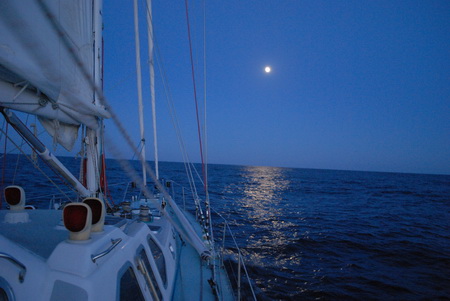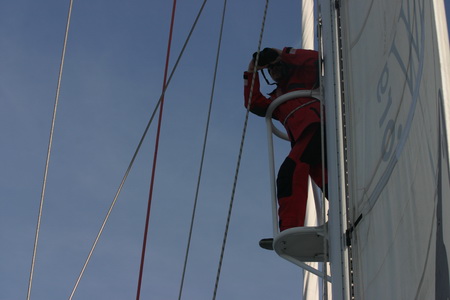The weather is windy and the sea choppy when we leave Plymouth and head out towards the French coast, but it feels so good to be at sea again! Due to the rather rough conditions, we are unable to use the A-frame as the observation platform, but even despite this, Jim manages to spot a harbour porpoise from the deck in the afternoon, and with the hydrophone in the water behind us, we are confident that our acoustic detectors will pick up more porpoises than we can see. There are quite a few species of cetacean that are particularly hard to detect visually, due either to their small size, elusive nature or long and deep dives – these include beaked whales, sperm whales and porpoises (including the highly endangered Mexican Vaquita) – all of which we have worked with over the years with the aim of developing acoustic detectors to facilitate improved survey ability and to compliment more traditional sighting surveys. The wind and waves start to die down as we passed the Les Sept and Les Triagoz Isles that night, and finally turn west to continue our journey northwards from the town of Morlaix, France.
As the sun rises the next day, the weather looks promising, with blue skies and sunshine. But as the morning watch climb onto the A-frame it soon becomes apparent that the cold wind is going to prevent anyone getting their shorts out and the waves won’t make sightings easy. Despite this we shake out a couple of reefs and enjoy a good days sailing across the channel, making good speed. As night falls and with calm weather forecasted everyone retreats to their cabins to grab as much sleep as possible before we arrive back on the French coast in the morning, hoping to find some porpoises waiting on the other side.
Porpoises do not appear the next morning but mid Channel we have a group of 5-8 common dolphins bow riding the Song of the Whale, including 2 calves which makes for an exciting start to the day. Throughout the day however, the wind increases and by the afternoon it is clear that we should take shelter from the rough seas as no observation was possible and increasing wave noise was making the acoustic data collection more difficult. We anchor off Camaret, France for a full night and day to wait out the worst of the summer storm.
After spending the day at anchor surrounded by thick fog and barely able to see the shoreline at Camaret, as night falls the winds die so we lift anchor, set sail and headed off again into the Channel. The fog is thick and atmospheric with shadows of rocks appearing in the beam of the moving lighthouses. Luckily the tide and winds are with us making the passage back through the Channel de Four and Channel de la Helle relatively easy. The fog stays with us through until morning by which time we have finished our track towards Lands End and our last crossing of the Channelis complete.
By dawn the fog clears and the shipping traffic thins. The further north we travel the more the conditions moderate until itis suddenly a proper summer afternoon. We pass the Wolf Rock light, before turning to West across the traffic separation scheme, towards the Isles of Scilly, which being very low lying, only unwillingly heave themselves above the horizon. As we follow our transects south again we enjoy an amazing sunset over St Martin before the islands fade away again into the distance.
By morning we are west of the Isles of Scilly again and enjoy a beautiful sunrise over calm seas. The sea conditions are perfect for observations at the beginning of the day, with an oily glassy sea and within the first hour watch we have already had three porpoise sightings. A lot of birds were seen as well, including storm petrels, terns, skuas, gannets, fulmars and gulls. We try to take full advantage of the good weather with our chief scientist climbing into the crow’s nest for some dual platform observations. Unfortunately, no sooner has he climbed the mast, the swell and winds start increasing again and the conditions deteriorate. We finish the last track of the harbour porpoise survey during the afternoon and start heading back to Plymouth, to drop off our visiting crew members.
As a whole, the survey has taken 22 days with 19 sightings, fifteen of which have been harbour porpoises, two dolphin species, one loggerhead turtle and one shark. We have suffered from unfortunate weather conditions for this time of year with only two mornings of calm weather, which for this elusive species, is key to visual observation. Now with the field work finished, we will start detailed analysis of our acoustic data collected from this survey and see how our detection rate increases.


Sorry, comments are closed for this post.